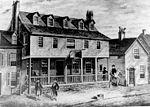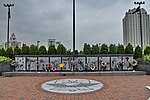Penn's Landing

Penn's Landing is a waterfront area of Center City Philadelphia along the Delaware River. Its name commemorates the landing of William Penn, the founder of Pennsylvania in 1682. The actual landing site is farther south in Chester, Pennsylvania. The city of Philadelphia purchased the right to use the name. Penn's Landing is bounded by Front Street to the west, the Delaware River to the east, Spring Garden Street to the north, and Washington Avenue to the south, and is primarily focused on the Christopher Columbus Boulevard (Delaware Avenue) corridor. Development of the area is handled by the Delaware River Waterfront Corporation. The corporation is a non-profit that was established in 2009 to manage the publicly owned land on the central waterfront on behalf of the City of Philadelphia and the Commonwealth of Pennsylvania.
Excerpt from the Wikipedia article Penn's Landing (License: CC BY-SA 3.0, Authors, Images).Penn's Landing
Delaware River Trail, Philadelphia Center City
Geographical coordinates (GPS) Address Website Nearby Places Show on map
Geographical coordinates (GPS)
| Latitude | Longitude |
|---|---|
| N 39.94564 ° | E -75.14072 ° |
Address
Independence Seaport Museum
Delaware River Trail
19106 Philadelphia, Center City
Pennsylvania, United States
Open on Google Maps











